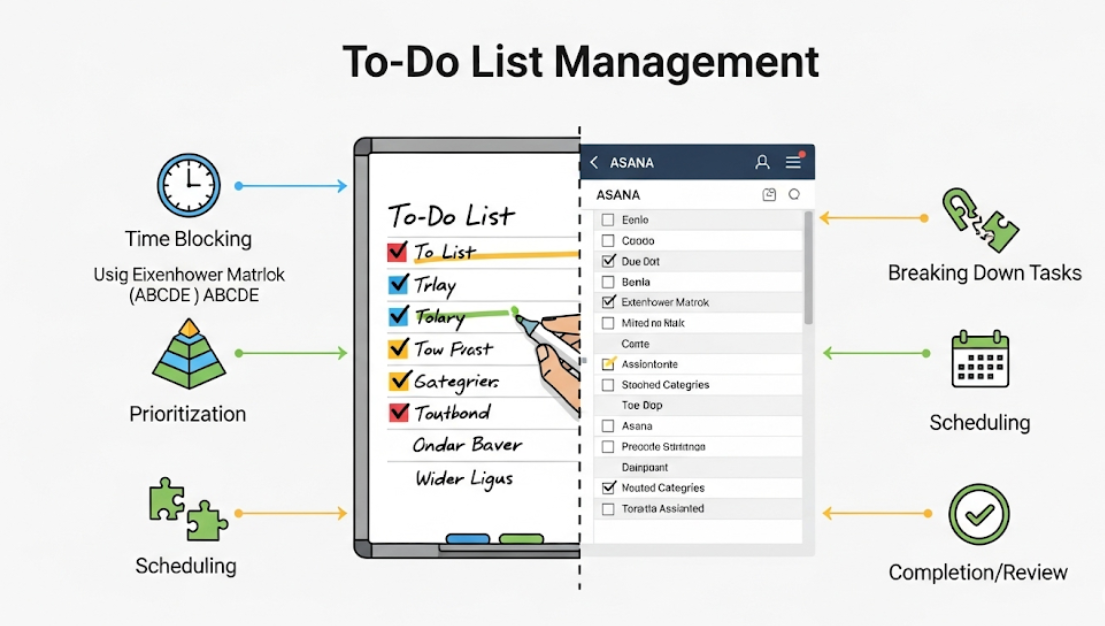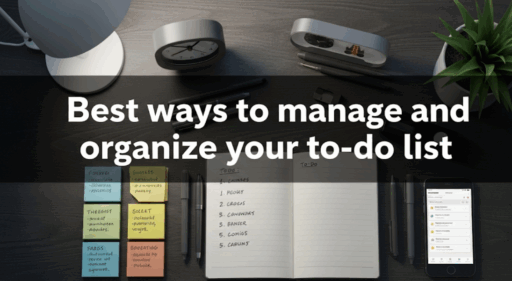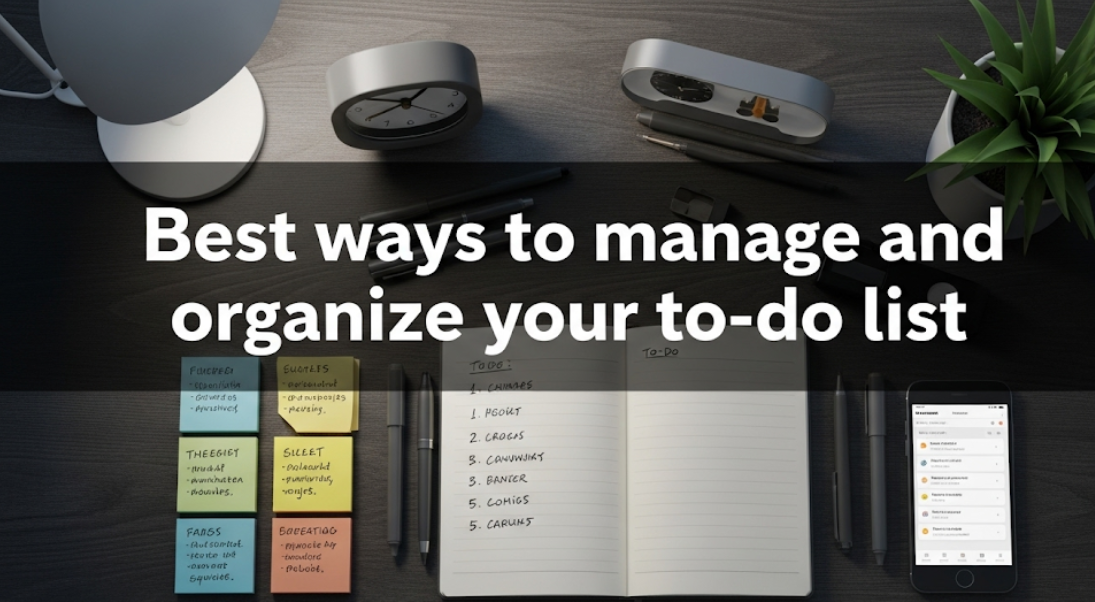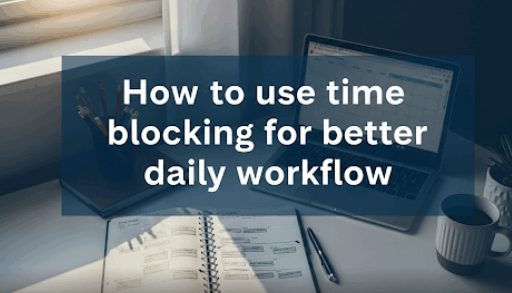The Best Ways to Manage and Organize Your To-Do List
Imagine this: Monday morning arrives, and your mind finds itself filled with a million things at once. You need to buy groceries, finish that work project, call your dentist, answer emails, and somehow find time to exercise. Does that situation sound familiar to you? In that case, you are not alone. It is safe to say that most people, myself included, are terrible at keeping track of things and planning ahead. More often than not, it feels like there is just not enough time in a day.
However, a to-do list is not just some piece of paper where you jot down what you need to do. A well-made to-do list is your pathway to less stress and more productivity. When utilized properly, a good to-do list can create clarity and help you do more while being less stressed. However, the secret is not to make a to-do list but rather know how to manage and organize one.
This guide will offer you proven tools that successful people use to dominate their everyday lives. From choosing the right tools to prioritizing at a professional level, this guide has you covered on everything you need to transfer your scattered thoughts into an efficient system that works.
What is Wrong with Your Current To-Do List
There is a high probability that your to-do list looks like this random set of words: a list of all done daily deadlines causing random stress. In this case, the list is probably causing more stress than relieving it.
How to Find & Create the Ideal To-Do List System for You
To get started with better task management, you need to use the right system for you and your life. But the issue is not one-size-fits-all, so here you will get excellent ways to work on it.
Finding Your Fit: Digital vs. Paper
Digital To-Do Lists Are Right For You If You: • Will have your phone or computer nearby most of the time • Prefer using technology to keep yourself organized over writing in a notebook • Have tasks that need to be shared with family or colleagues • Need notifications for events and reminders automatically added for you • Want to quickly search through old tasks that you completed
Paper To-Do Lists Are For You If: • Think and remember better when you write your thoughts out rather than type them on the computer • Find other digital tools to be a bit too distracting to use for managing your list of things to do • Enjoy the act of marking off items completed with a pen • Rather not spend any more time in front of a screen organizing your day-to-day life • Like color coding or doodling around different sections to create a more personal experience
Popular Digital Tools
| Tool | Best For | Main Features | Pricing |
|---|---|---|---|
| Todoist | All-around task management | Organization of projects, tags, filters | Free/Premium |
| Any.do | Simple daily planning | Clean interface, daily planner | Free/Premium |
| Microsoft To Do | Office users | Integration with Outlook, shared lists | Free |
| Apple Reminders | iPhone/Mac users | Siri integration, location reminders | Free |
| Notion | All-in-one organization | Databases, templates, collaboration | Free/Paid |
Paper System Options
The Bullet Journal Method: This system is symbol-based and flexible, allowing you to categorize tasks, events, and notes in a way that works for you. Design layouts that fit best for your specific use.
Basic Notebook: Take a notebook and organize it by having one sheet per day (or per week). Create boundaries between each area of your life.
Pre-Made Planners: Buy pre-designed planners for task management with built-in systems to rank priority and track goals.
Effective Ways to Prioritize Smartly
It literally does not mean anything to have a list of things when there is no order to it. Here are three practical ways to prioritize like a pro.
The Eisenhower Matrix: Urgent vs. Important
The Eisenhower Matrix divides all tasks into four categories:
Quadrant 1: Urgent and Important (Do First) • Medical emergencies • Project deadlines today • Crisis situations • Last-minute important meetings
Quadrant 2: Important but Not Urgent (Schedule) • Exercise and health activities • Learning new skills • Planning and preparation • Relationship building
Quadrant 3: Urgent but Not Important (Delegate) • Some phone calls • Certain emails • Interruptions from others • Some meetings
Quadrant 4: Neither Urgent nor Important (Eliminate) • Excessive social media browsing • Time-wasting activities • Unnecessary meetings • Mindless TV watching
Invest most of your time in Quadrant 2 activities, which eliminate the crises of Quadrant 1.
The ABCDE Method of Prioritizing Your Daily Tasks
Rate each task with a letter:
• A Tasks: Must do – serious consequences if not completed • B Tasks: Should do – mild consequences if not completed • C Tasks: Nice to do – no consequences if not completed • D Tasks: Delegate to someone else • E Tasks: Eliminate unnecessary tasks
A tasks should be done before B, etc.
The 3-2-1 Daily System
Every day, choose: • 3 high-level tasks that drive you further toward your goals • 2 medium-level tasks that require attention but are not urgent • 1 small task you can check off really fast
This treats you to 6 tasks a day, which avoids overwhelm but also ensures you are doing something every day that has meaning.
Time-Based Organization Strategies
When you organize your tasks by time, it makes how you work more efficient and reduces the mental energy required to decide what to do next.
Time Blocking Your Tasks
Rather than having a list of tasks, indicate the specific time each task would take:
Morning Block (8 AM – 12 PM): • High-energy focus tasks • Important meetings • Creative work
Afternoon Block (1 PM – 5 PM): • Routine tasks • Email and communication • Administrative work
Evening Block (6 PM – 8 PM): • Personal tasks • Plan for the next day • Light activities
The Two-Minute Rule
If a task takes you less than 2 minutes to complete, do it right away—no need to write it down. This way, even the smallest of tasks do not accumulate and clutter your system.
Batch Similar Tasks Together
Group similar tasks together to stay focused and productive:
• Communication Batch: Emails, calls, messages • Errands Batch: Grocery shopping, post office, dry cleaning • Administrative Batch: Paying bills, filing documents, scheduling appointments • Creative Batch: Writing, designing, brainstorming
Creating Categories That Make Sense
Categorizing makes sure that you can easily access what needs to be done and also ensures that every sphere of life has balance.
Life Area Categories
Work: • Daily projects • Project deadlines • Meetings and presentations • Personal development • Networking efforts
Personal: • Health and fitness • Family relationships • Home repairs • Personal finances • Hobbies
Self-Care: • Mental health • Physical wellness • Spiritual growth • Learning • Rest
Context-Based Categories
Break down tasks by location or method you will do them:
• Home: Clean, organize, spend time with family • Office: Work assignments, meetings, business tasks • Online: Research topics, social media interactions, shopping online • Phone Calls: Make appointments, customer service calls, talk to friends • Errands: Bank visits, grocery shopping, post office
Energy-Based Categories
Match tasks to your energy levels during the day:
• High Energy Tasks: Complex problem solving, big decisions, creative work • Medium Energy Tasks: Routine tasks, organizing, planning • Low Energy Tasks: Filing, data entry, simple organization

How to Write Great Task Descriptions
The way you write your tasks plays a big role in whether you are willing to complete them.
Make Tasks Specific and Actionable
Instead of: “Work on presentation” Write: “Create 10 slides for marketing presentation using Q3 sales data”
Instead of: “Clean house” Write: “Vacuum living room, wash dishes, and organize bedroom closet”
Instead of: “Exercise” Write: “Go for 30-minute walk around the neighborhood”
Include Time Estimates
This gives you a better idea of how much time something will take and helps you plan your day adequately.
• “Quarterly report review (45 minutes)” • “Grocery shopping (1 hour) — plan meals for the week” • “Call insurance company about claim (15 minutes)”
Add Context When Needed
Include context that will help you carry out the action:
• “Purchase birthday gift for Sarah ($30 budget; she likes books and coffee)” • “Book dentist appointment (Thursdays preferred)” • “Research European vacations (July dates)”
Review and Refine Your System
A to-do list is only helpful if you take action on it. Periodic reviews help you make sure that the system is still relevant and serves its purpose.
Daily Review Process (5 minutes)
Every morning: • Review yesterday’s incomplete tasks • Add any new tasks that need to be performed • Identify top 3 priorities for today • Check appointments and deadlines from your calendar
Every evening: • Mark completed tasks (celebrate!) • Move incomplete tasks to tomorrow or reschedule • Write down anything new for tomorrow • Organize your workspace ready for the following day
Weekly Review Process (15 minutes)
Every Sunday: • Review the past week’s accomplishments • Identify tasks that keep getting put off • Plan the upcoming week’s priorities • Remove outdated items from your to-do list • Adjust your system if something is not working
Monthly System Evaluation
Consider these questions: • Does my present system help me accomplish my goals? • What tasks do I always put off? • Are my categories consistent with the realities of my actual life? • Should my time estimates be adjusted? • Is there another tool or approach that I should be using?
Advanced Tips for Power Users
Once you master the core techniques, try these advanced strategies for even greater productivity.
The Someday/Maybe List
Create another list for future ideas and tasks that aren’t top of mind right now but could be in the future. Check this list monthly to see if it’s time to include any of these in your active tasks.
Task Dependencies and Project Management
Complex projects need to have task dependencies mapped:
Project: Plan Birthday Party
- Select date and send out invitations (Week 1)
- Order decorations and book cake (Week 2 – after RSVPs)
- Prepare food and set up space (Day of event)
Habit Stacking with Tasks
Attach new tasks to existing habits: • “After I drink my morning coffee, I will review my tasks” • “Every time I check my email, I will update my priority list” • “After dinner, I will plan my 3 top tasks for tomorrow”
The Power of Templates
Create templates for recurring responsibilities:
Weekly Review Template: • Review last week’s goals • Identify 3 priorities for the week • Schedule appointments you cannot miss • Plan one self-care activity for the week • Choose one area of life to focus on this week
Project Launch Template: • Clearly define goals and success metrics • Divide project into smaller components • Set milestone deadlines • Identify what resources are needed at each stage • Schedule regular check-ins
Troubleshooting Common Problems
Even the best systems sometimes fail. Here’s how you can overcome the biggest problems with to-do lists.
Issue: Too Many Tasks, Not Enough Time
Solutions: • Create a “not-to-do list”—write down things you are going to stop doing • Practice saying no to non-essential requests • Delegate tasks whenever possible • Focus only on top 3 daily priorities
Problem: Tasks Keep Getting Postponed
Solutions: • Break down projects into smaller, more manageable steps • Schedule tasks during your best energy times • Identify and remove barriers that make tasks harder • Build in accountability by sharing your goals with others
Issue: No Motivation to Keep the System Up
Solutions: • Reward yourself for completing tasks • Remind yourself why being organized is important to you • Make your system enjoyable (use stickers, colors, etc.) • Find an accountability partner
Problem: System Becomes Too Complicated
Solutions: • Simplify by reducing unnecessary sections or features • Focus on the 20% that gives you 80% of the results • Return to basic methods until you get back in the habit • Choose tools with fewer bells and whistles
How to Make Your To-Do List Work for Your Lifestyle
The best productivity system is the one you actually use. Consider these lifestyle factors when choosing your strategy.
For Busy Parents
• Use voice-to-text features to add tasks instantly • Share family lists for household chores • Set reminders for self-care and important personal tasks • Build flexibility for unexpected changes
For Students
• Keep academic tasks separate from personal ones • Block study time for each subject • Prioritize tasks with due dates and exams • Use templates for recurring assignments
For Remote Workers
• Draw clear lines between work and personal tasks • Block your calendar for productive work time • Include breaks and transitions in your schedule • Set shutdown rituals at the end of your workday
For Entrepreneurs and Freelancers
• Separate client work from business development tasks • Include time for marketing and networking • Focus on activities that drive growth • Schedule regular reviews to ensure you’re doing the right work
The Psychology of Effective Task Management
Understanding why to-do lists work (or don’t) can help you design a system that fits how your brain works.
The Zeigarnik Effect
Your brain remembers incomplete tasks better than completed ones. Writing things down gives you mental clarity and ensures nothing gets forgotten.
Dopamine and Completion
Checking items off your list releases dopamine, which reinforces productive behavior. This is why breaking big tasks into smaller ones increases your likelihood of completion.
Decision Fatigue Prevention
Having a system in place reduces the number of decisions you make throughout the day, preserving mental resources for more important choices.
Building Trust with Yourself
Every time you follow through on your planned tasks, you create a positive feedback loop that strengthens the connection between planning and action.
Your Journey to To-Do List Mastery Starts Here
Perfection comes with practice, and you will learn over time. Select 1 or 2 strategies from this guide that align best with your current situation and lifestyle to start. Remember, the goal is progress, not perfection.
The most successful people are not the ones who never get overwhelmed, but rather those who know how to handle their overwhelming life with a proper system. Your to-do list should be a helpful assistant and not another source of stress.
Start with small changes and build momentum over time. Whether you choose a basic paper journal or an advanced digital method, the key is to make it automatic and refine it monthly. Your future, more focused self will thank you for taking charge of these tasks instead of feeling guilty about putting them off.
Do This Now: Choose one strategy from this article and take action on it this week. Take that first step in your journey to being more organized and stress-free.




